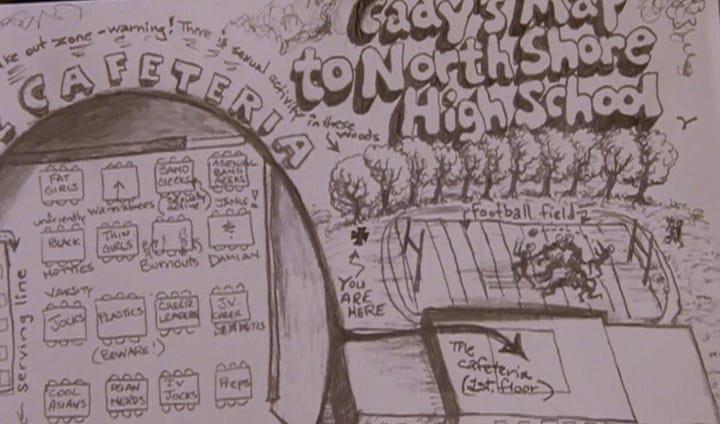Enneagram: A Tool for Self-Awareness
I always thought the movie Mean Girls was not just funny but a sharp-witted commentary on cliques in high schools. Even more impressive was how Tina Fey adapted the script from a self-help book, Queen Bees and Wannabes, not a novel. In an early scene, new student Cady Heron (played by Lindsay Lohan) is introduced to her peers at North Shore High School by Janice Ian via a hand-drawn map:


“This map is going to be your guide to North Shore…you got everybody there. You got your freshmen, ROTC guys, preps, J.V. jocks, Asian nerds, cool Asians, varsity jocks, unfriendly black hotties, girls who eat their feelings, girls who don't eat anything, desperate wannabes, burnouts, sexually active band geeks, the greatest people you will ever meet and the worst. Beware of Plastics”
That map divides the students into a collection of over-the-top and oh-so-wrong stereotypes: varsity jocks, unfriendly black hotties, desperate wannabes, and so on. You get the picture. Janice Ian would get so canceled today if that map had gone viral. Nevertheless, in the movie, categorizing the North Shore folks into various tribes, albeit politically incorrect, does help Heron make sense of her peers. It works because Heron starts observing her social boundaries – as defined in the map – and finds her rhythm.
Making Sense of Complexities Through Clustering
We are often told that stereotyping is bad. Humans are unique, and we need to honor individuality. Our world, however, is organized (and recorded) based on categories: nationalities, ethnicities, educational qualifications, professions, political affiliations, religions, and so on. When joining any new establishment or club or seeking new opportunities – professional, financial, political, or social – individuals often provide a litany of information that helps administrators (or, more likely, algorithms these days) infer everything, from job suitability and romantic matchmaking to creditworthiness and likelihood of terrorism, based on some commonalities displayed by historical patterns.
Grouping helps humans make sense of the world by simplifying and systematizing information to fit the rational part of our brains better. Organization by clusters helps us recall, identify, predict, and respond better, giving us greater clarity. With it, we can handle randomness and discombobulated information.
The Enneagram: Guide to Human Nature
What if we were given an equivalent guide to understanding human nature instead of a map of the school cafeteria to navigate North Shore High School in Mean Girls? Imagine possessing an intuitive, conceptual framework that helps us understand and respond better to the complexities of people. A map that goes beyond observable human behaviors by providing rich insights into underlying motivations organized by personality types.
Enter the Enneagram.
The Enneagram is a model of nine interconnected archetypical personalities, as represented by nine equidistant points on the circumference of an Enneagram circle. Instead of “desperate wannabes” and “sexually active band geeks,” we now have Enneagram types identified by neutral numerals, from Type One (Perfectionist) to Type Nine (Peacemaker):
As a believer in self-help, I have found the Enneagram useful for my self-awareness. The system offers one of the best psychological frameworks for introspection because it looks beneath the surface of human manners to explore the underbellies. Dividing personalities into distinct archetypes also allows for easier recognition of self and others.
Enneagram x Investing
Enneagram has become popular recently, enjoying increasing scientific validations and expanding use cases. Major corporations such as Boeing, Google, and Microsoft use the Enneagram in their employee training to increase productivity and foster teamwork.
Where money is involved, it is easy for deeply wired triggers and ingrained personality biases to take over our responses. Self-understanding is, hence, key to our lifelong investing journeys. Our best traits and core motivations are often accompanied by closely related blind spots and unhealthy biases. Our typology helps to clarify because it can reveal specific personality pitfalls we face in personal investing.
Below are recent posts I have written about Enneagram types and their stock-picking habits:
Enneagram x Stock Picking (Part I): Type One Perfectionists
Enneagram x Stock Picking (Part II): Type Twos Investing in AMC to Save Movie Theaters?
Enneagram x Stock Picking (Part III): Type Three Investors, Successes, and Delaying Gratification
Enneagram x Stock Picking (Part IV): Type Four Investors and their Emotions
Enneagram x Stock Picking (Part V): Type Five Investors inside their Heads
Enneagram x Stock Picking (Part VI): Type Six Skeptics
Enneagram x Stock Picking (Part VII): Type Seven Enthusiasts
Enneagram x Stock Picking (Part VIII): Type Eights
Enneagram x Stock Picking (Part IX): Type Nine Peacemakers
You can try the free test on my website if you want to learn more about your Enneagram type.
Update: As of August 2024, I signed a publishing deal with Köehler Books to turn the Enneagram x Investing concept into a book tentatively titled Suit Yourself.
Subscribe below to join me on my journey to publication and learn more about my ongoing portfolio management!
Meantime, follow me on Twitter @ConsumeOwnTech




